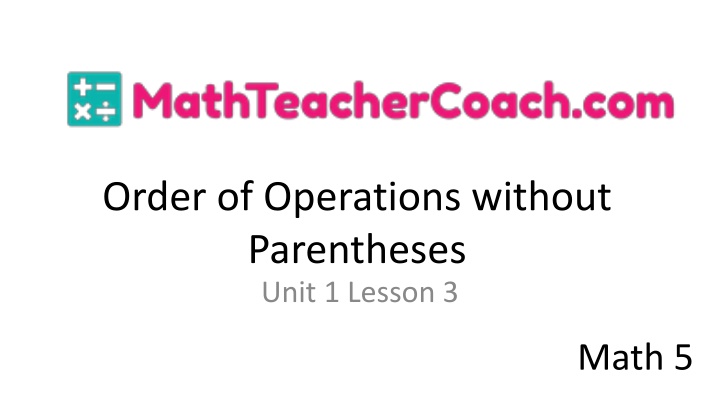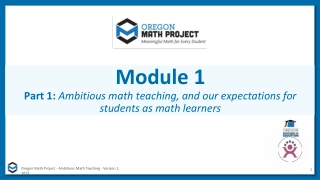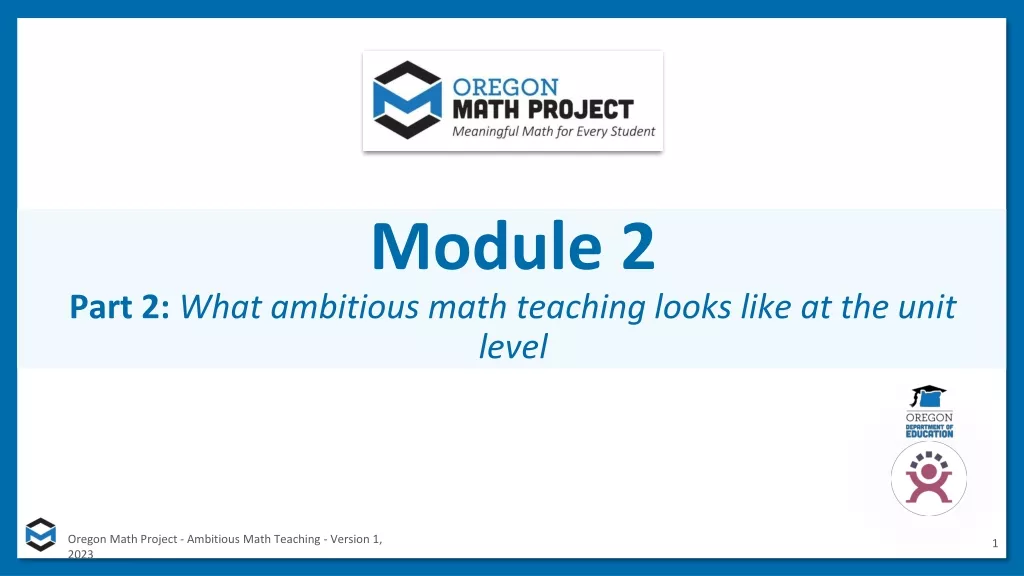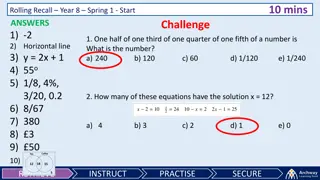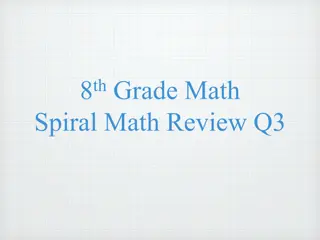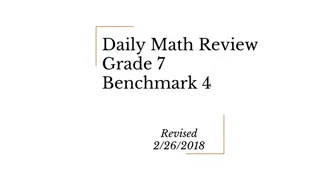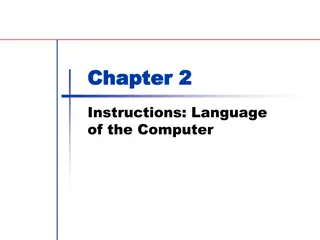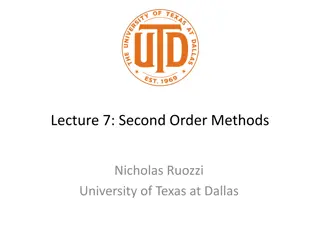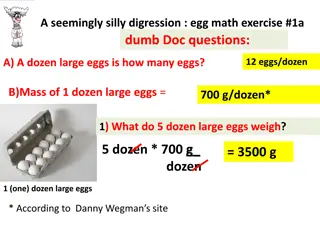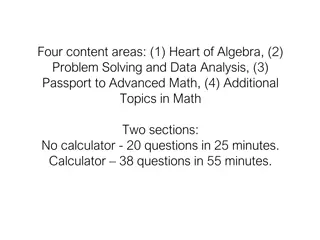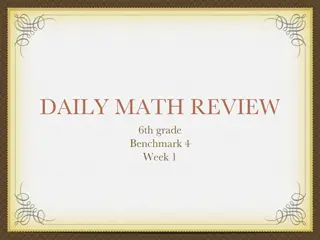Order of Operations in Math
Fundamentals of order of operations in math without parentheses, including identifying the correct sequence of operations and evaluating numerical expressions. Learn key vocabulary and methods to solve problems effectively.
Download Presentation

Please find below an Image/Link to download the presentation.
The content on the website is provided AS IS for your information and personal use only. It may not be sold, licensed, or shared on other websites without obtaining consent from the author.If you encounter any issues during the download, it is possible that the publisher has removed the file from their server.
You are allowed to download the files provided on this website for personal or commercial use, subject to the condition that they are used lawfully. All files are the property of their respective owners.
The content on the website is provided AS IS for your information and personal use only. It may not be sold, licensed, or shared on other websites without obtaining consent from the author.
E N D
Presentation Transcript
Order of Operations without Parentheses Unit 1 Lesson 3 Math 5
Order of Operations without Parentheses Students will be able to: Identify the order of operation in a numerical expression (without parentheses). Demonstrate understanding on the order of operations in a numerical expression (without parentheses). Evaluate numerical expressions (without parentheses) using MDAS rule. Evaluate numerical expressions (without parentheses) using the funnel method. Solve problems involving numerical expressions, following the correct order of operations.
Order of Operations without Parentheses Key Vocabulary: Numerical Expression Order of Operations MDAS Rule Funnel Method Evaluate
Order of Operations without Parentheses Order of Operations Similar to the word order,is the word arrangement . Operations on the other hand would mean to add, subtract, divide and multiply. So Order of Operations means the correct arrangement of the operations involved in a numerical expression.
Order of Operations without Parentheses For instance, James and Sally were asked to give the value of ? + ? ??. Who do you think did it right?
Order of Operations without Parentheses It s very clear that Sally and James came up with different answers. Both steps may look OK, but only ONE is correct, and the other one is just deceiving you! Questions like What should go first? and What must be done next? are just some of the many questions when asked to EVALUATE numerical expressions.
Order of Operations without Parentheses Evaluating Numerical Expressions (without Parentheses) The word EVALUATE means to calculate or to get the value of a given expression. Going back to the answers of James and Sally, they were asked to evaluate: ? + ? ?? ?
Order of Operations without Parentheses As mentioned earlier, there could only be ONE correct answer. Below is the comparison of the order of operations each of them used.
Order of Operations without Parentheses It s very clear that Sally and James came up with different answers. Both steps may look OK, but only ONE is correct, and the other one is just deceiving you! Questions like What should go first? and What must be done next? are just some of the many questions when asked to EVALUATE numerical expressions.
Order of Operations without Parentheses Evaluating Numerical Expressions (without Parentheses) The word EVALUATE means to calculate or to get the value of a given expression. Going back to the answers of James and Sally, they were asked to evaluate: ? + ? ?? ?
Order of Operations without Parentheses As mentioned earlier, there could only be ONE correct answer. Below is the comparison of the order of operations each of them used.
Order of Operations without Parentheses So who got it right??? Sally got it right!!!
Order of Operations without Parentheses In Mathematics, we need to make sure that answers are accurate and valid. How do we make sure that they are accurate and valid ? Why is James incorrect? To get the accurate and valid answer, there are certain rules to be followed. You can t just do anything whichever you like and however you would want to. What are those RULES?
Order of Operations without Parentheses Multiplication Division Addition Subtraction (MDAS) Following a pattern, arrangement, or order in evaluating numerical expressions will definitely lead you to the correct answer. Let s first evaluate numerical expressions without parentheses using the MDAS rule.
Order of Operations without Parentheses Let s find out why Sally got it right and James didn t!
Order of Operations without Parentheses Let s find out why Sally got it right and James didn t!
Order of Operations without Parentheses WARNING!!!... One wrong move and you ll get it all WRONG !
Order of Operations without Parentheses Example: Sam and Paul were asked to evaluate ?? + ? ? ?? ?. Each of their solution is shown below. Who among the two followed the MDAS rule? Explain your answer.
Order of Operations without Parentheses Example: Sam and Paul were asked to evaluate ?? + ? ? ?? ?. Each of their solution is shown below. Who among the two followed the MDAS rule? Explain your answer. Solution: The one who did it right is Sam. He followed the MDAS rule. First he multiplied 4 and 5 to get 20, and then got the quotient of 10 and 2 which is 5. Next, he got the sum of 15 and 20 which is 35. Lastly, he got the difference of 35 and 5. They were all done from left to right. Paul on the other hand is incorrect because even though he worked form left to right, he failed to follow the MDAS rule.
Order of Operations without Parentheses Sample Problem 1: The numerical expression ?? + ?? ? ? ?? is solved in two different ways with different answers.
Order of Operations without Parentheses Sample Problem 1: a. Which among the two solutions is correct and why? b. What makes the other one incorrect?
Order of Operations without Parentheses Sample Problem 1: Solution: a. Which among the two solutions is correct and why? Solution B is correct because the step followed the MDAS rule. b. What makes the other one incorrect?
Order of Operations without Parentheses The Funnel Method To make sure that you get the CORRECT answer, the use of the FUNNEL METHOD can help. Why is it called FUNNEL METHOD? Because it looks like a funnel! The examples we did earlier made use of the funnel method.
Order of Operations without Parentheses The Funnel Method
Order of Operations without Parentheses Example: Evaluate the numerical expression ? + ?? ? ? ?using the funnel method.
Order of Operations without Parentheses Sample Problem 2: Evaluate the following numerical expressions. a. 10 + 5 6 10 13 b. 45 15 3 + 2 4 + 3
Order of Operations without Parentheses Order of Operations in Real World The MDAS rule is also used to solve real-life problems. These problems happen on a daily basis, without us realizing that we are using such rule. See the example on the next slide:
Order of Operations without Parentheses Sample Problem 3: Read the situation below and answer the questions that follow. Paul bought 4 burgers for $2.50 each and 4 medium fries for $1.25. a. Write a numerical expression that represents the problem. b. How much money did Paul spend?
